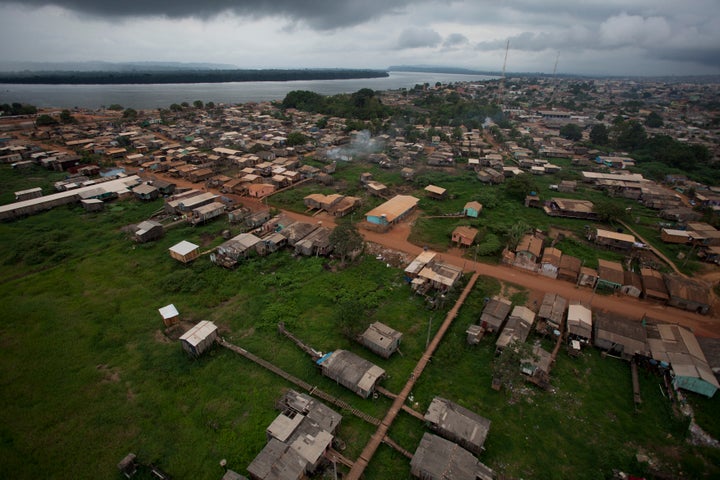ALTAMIRA, Brazil ― The first signs of the fires arrived in Belem, in the northern Brazilian state of Pará, early last Friday afternoon, when thick plumes of black smoke suddenly darkened a sunny day.
The blazes had started hundreds of miles to the south in Altamira, a sprawling and sparsely populated municipality where rampant deforestation has erased vast stretches of the Amazon rainforest at a faster rate than anywhere else in Brazil.
Nearly a decade ago, Altamira sat at the center of another major environmental dispute, over the construction of a massive hydroelectric dam on a tributary of the Amazon River. The dam led to a boom in construction and the area’s population, but indigenous tribes, environmental groups and scientists warned that Altamira would one day become ground zero in an Amazonian crisis.
Now, the black sky blanketing Belem seemed like the surest sign that day had arrived.
As the smoke cleared, an even uglier picture came into view. Corruption and environmental indifference have eroded the government regulatory agencies in charge of protecting the forest, and the recent outbreak of fires has exposed a “collapsed” state incapable of preventing such blazes and responding to them once they occur.
“It’s no use coming with a plane to put out the fire,” said Thais Santi, a federal public prosecutor for Altamira. The problems, she said, are much larger than anyone wants to admit. “The city has experienced a population boom. It has doubled in size. But the state has not [kept up].”
Years Of Warnings

The bulk of the blame for the Amazon fires has fallen on right-wing President Jair Bolsonaro, who has used the first year of his presidency to roll back environmental regulations, gut agencies charged with protecting the Amazon, and target the indigenous populations who live in and protect the forest.
His administration, meanwhile, has been slow to react to the blazes and has instead blamed the international community for stoking “hysteria,” as his ambassador to the United States suggested this week.
But the environmental problems in Altamira started long before Bolsonaro.
In the early 2000s, Brazil’s leftist governments toughened environmental regulations and strengthened enforcement of laws meant to protect the Amazon, with dramatic results. Even as the Brazilian economy boomed, Brazil slashed its rate of deforestation by 70 percent and reduced carbon emissions faster, and more, than any country in the world.
But the thirst for energy in a rapidly growing country remained strong, and the same governments that made protecting the Amazon a priority also approved Belo Monte, a massive new hydroelectric dam project along the Xingu River in Altamira.
At the time, environmental groups and indigenous activists warned that the dam project “would divert the flow of the Xingu River and devastate an extensive area of the Brazilian Amazon rainforest, threatening the survival of indigenous peoples,” as the nonprofit group Amazon Watch said in 2012, when the project was approved.
Construction on the dam displaced between 20,000 and 50,000 residents, according to various estimates, and cut off the Xingu’s waters from indigenous and other local populations that depended on it. Belo Monte also prompted new infrastructure projects meant to service the dam and the surrounding areas, which in turn led to increased deforestation of the Amazon ― including on protected indigenous lands.
“It was the biggest human rights violation I ever imagined,” Santi said.
Government officials and lawmakers who approved the project have been accused of bribery and environmental agencies signed off on the dam despite an incomplete environmental impact assessment. Meanwhile, activists have said the construction consortium that built the dam has failed to live up to promises it made to protect the environment, indigenous tribes and other local residents who opposed its construction.
Belo Monte’s construction drew tens of thousands of workers and new residents to the area ― in just two years, Altamira’s population exploded from 100,000 to 160,000. It transformed the city, and to many local officials, the dam is a sign of the sort of economic boom development can bring to poor, underserved regions like Altamira.

But many of the worst fears about the dam’s destructive environmental effects have come true, and to Santi, there are clear links between the Belo Monte-driven population boom and increased environmental destruction.
“Belo Monte brought more people [and] made the area more attractive, better known, and easier to access,” Santi said. “The pressure on indigenous lands has increased a lot.”
The deforestation rate jumped 15% in 2009, as the dam project neared approval, and Altamira has been home to the Amazon’s highest rate of deforestation for seven consecutive years.
Belo Monte has changed the flow of the Xingu River in a way that has devastated local fish populations, according to studies.
Fights between illegal land-grabbers and local and indigenous populations have spiked, according to residents and human rights activists who for years have attempted to draw attention to the destruction of protected forest lands in Altamira. Already-rising rates of deforestation have skyrocketed this year, as Bolsonaro has rolled back environmental regulations and signaled to ranchers, farmers, and Brazil’s influential agribusiness industry that he will not enforce the rules that do exist. Besides Altamira, no municipality in Brazil has experienced a more dramatic increase in the number of felled trees so far in 2019. From January to July, according to official statistics, it lost 297 square kilometers of forest ― an area larger than the state of São Paulo.
Altamira’s growth stressed existing government agencies and crime spiked: The number of homicides rose from 79 in 2012 to nearly 150 in 2017, according to government statistics. In July, 57 inmates died at a prison facility in Altamira when clashing gangs sparked a riot, a problem many experts attributed to Brazil’s mass incarceration crisis, overburdened institutions and the urban poverty and marginalization that resulted from the dam project, especially when construction ended and many of the jobs evaporated.
Brazil’s federal police have tried to keep up with the rising rates of deforestation: As of Aug. 27, they have launched 157 environmental investigations in Altamira so far this year, up from just 67 throughout all of 2018. But overall, enforcement has dropped. The number of fines the Brazilian government issued over the first eight months of Bolsonaro’s presidency decreased by nearly a third from a year ago, while the number of fires in the Amazon increased by 84 percent.
On Aug. 5, ranchers and farmers in the Amazon launched a “Day of Fire,” which they had organized on WhatsApp. The plan was simple: To celebrate Bolsonaro’s gutting of environmental regulations, they set fire to the forest, flaunting the lack of oversight and repercussions. There have been more than 2,200 fires set in Altamira so far in August, a staggering 794% increase from a year ago, according to official statistics.
Bolsonaro’s effort to roll back environmental rules “has caused a dramatic increase in deforestation in that area,” a top Brazilian environmental official told Reuters this week.
The demonstration didn’t just torch the Amazon ― it also exposed how frail the government’s ability to combat illegal deforestation in Altamira can be even when local enforcement agencies try to do their jobs: State authorities in Pará said they had warned the federal government about the plans to torch forests in the area, but received no response.
Years of inadequate funding, meanwhile, had left state and federal agencies that operate in the area understaffed and overwhelmed even before the sharp uptick in deforestation.
In Altamira, the agencies responsible for year-round environmental inspections have few employees: There are just three employees from the federal environmental agency and two from the land reform and use department.
Altamira’s federal highway police force ― which is charged with stopping smugglers of illegally deforested timber and other products ― is similarly threadbare.
“Ideally, we would have at least four people present each day at our checkpoint, due to the harsh conditions we face here, including danger to our security,” highway officer Ítalo Carneiro said.
But instead, they usually work in pairs. That, Carneiro said, has left police largely incapable of adequately confronting the dozens of smugglers transporting illegal timber out of the forest, especially when those smugglers are armed. That’s assuming the police even spot the smugglers at all: Illegal loggers hoping to move their cargo to the cities and ports on the northeastern coast of Brazil often have no trouble avoiding police checkpoints ― and any potential punishment ― at all. And although police are familiar with the alternative routes the smugglers use, understaffing prevents them from conducting operations and covering enough area to put a dent in the practice.
“When there are only three of us here [at the checkpoint],” Carneiro said, “one of us stays here, which is a danger in itself in this region, and two go out on the operation. We never go out alone.”
A ‘Hurried And Confused’ Response

Bolsonaro has fired back at his international critics, including French President Emmanuel Macron, and said that Brazil is the victim of an international conspiracy to violate its sovereignty and take away its control of the Amazon.
The president and his cabinet members have insisted that Brazil is on top of everything.
“Much has been said about the situation being out of control. It really isn’t,” Defense Minister Fernando Azevado e Silva said this week. “The situation isn’t simple, but it’s under control and is improving considerably.”
On the ground in Altamira, it is clear that the years of indifference have now given way to a frenzied and inadequate response.
Bolsonaro this week sent national public security forces to states that need help fighting the outbreak of fires, including Pará. Reinforcements arrived to Altamira soon after.
But Mario Sergio Nery, the federal police chief in Altamira, described Bolsonaro’s efforts to send national forces to the Amazon region as “hurried and confused.” Authorities there still don’t have the equipment they need to fight the fires, Nery said.
“It looks like something done for show,” Nery said. “I’ve never seen any actual work done like this. They’ve sent manpower over, but there’s nothing for them to use.”
Officials from various government agencies have held meetings all week, and attempted to form a strategy for securing the forest and holding illegal loggers accountable. But there is still no logistical plan for combating the fires, officials told HuffPost Brazil. Any actual work toward limiting the blaze won’t start until at least Monday, an official from the 51st Forest Infantry Battalion in Altamira said.
The federal police in the area launched an investigation into the “Day of Fire” this week, and National Justice Minister Sergio Moro promised to make it a priority. The government, meanwhile, banned the setting of new fires for 60 days.
But Altamira is a vast municipality that covers more than 60,000 square miles, and its infrastructure hasn’t kept up with the population boom. Poor roads and unpaved highways mean a trip 750 miles to the south, to the center of the fires, can take as long as two days. And it remains unclear whether the Brazilian government’s response will be aggressive enough to make up for the problems authorities in Altamira have faced for so long.
“Traveling in the region requires time, personnel and equipment,” Nery, the police chief, said. “We don’t have the resources required in this region.”
Débora Álvares reported from Altamira, Brazil. Travis Waldron reported from Washington.